Performance of T-Track® TB, a Novel Dual Marker RT-qPCR-Based Whole-Blood Test for Improved Detection of Active Tuberculosis
Abstract
1. Introduction
2. Materials and Methods
2.1. Study Design and Participants
2.2. Sample Collection
2.3. T-Track® TB Assay
2.4. QuantiFeron®-TB Gold Plus Assay
2.5. Statistical Analysis
3. Results
3.1. Study Participants’ Characteristics
3.2. Diagnostic Performance of T-Track® TB
3.3. Comparison of T-Track® TB and QFT-Plus Test Results
3.3.1. Qualitative Assay Performance Comparison
3.3.2. Qualitative Assay Concordance
3.3.3. Quantitative Assay Correlation
4. Discussions
5. Conclusions
Supplementary Materials
Author Contributions
Funding
Institutional Review Board Statement
Informed Consent Statement
Data Availability Statement
Acknowledgments
Conflicts of Interest
References
- World Health Organization (WHO). Tuberculosis (TB). Available online: https://www.who.int/news-room/fact-sheets/detail/tuberculosis (accessed on 3 November 2022).
- TB Alliance Global Pandemic. Available online: https://www.tballiance.org/why-new-tb-drugs/global-pandemic (accessed on 3 November 2022).
- Thillai, M.; Pollock, K.; Pareek, M.; Lalvani, A. Interferon-gamma release assays for tuberculosis: Current and future applications. Expert Rev. Respir. Med. 2014, 8, 67–78. [Google Scholar] [CrossRef]
- Grinsdale, J.A.; Ho, C.S.; Banouvong, H.; Kawamura, L.M. Programmatic impact of using QuantiFERON®-TB gold in routine contact investigation activities. Int. J. Tuberc. Lung Dis. 2011, 15, 1614–1620. [Google Scholar] [CrossRef]
- Piccini, P.; Chiappini, E.; Tortoli, E.; de Martino, M.; Galli, L. Clinical peculiarities of Tuberculosis. BMC Infect. Dis. 2014, 14 (Suppl. 1), S4. [Google Scholar] [CrossRef]
- Carranza, C.; Pedraza-Sanchez, S.; de Oyarzabal-Mendez, E.; Torres, M. Diagnosis for latent Tuberculosis infection: New alternatives. Front. Immunol. 2020, 11, 2006. [Google Scholar] [CrossRef]
- Sester, M.; Sotgiu, G.; Lange, C.; Giehl, C.; Girardi, E.; Migliori, G.B.; Bossink, A.; Dheda, K.; Diel, R.; Dominguez, J.; et al. Interferon-γ release assays for the diagnosis of active Tuberculosis: A systematic review and meta-analysis. Eur. Respir. J. 2011, 37, 100–111. [Google Scholar] [CrossRef]
- Whitworth, H.S.; Badhan, A.; Boakye, A.A.; Takwoingi, Y.; Rees-Roberts, M.; Partlett, C.; Lambie, H.; Innes, J.; Cooke, G.; Lipman, M.; et al. Clinical utility of existing and second-generation interferon-γ release assays for diagnostic evaluation of Tuberculosis: An observational cohort study. Lancet. Infect. Dis. 2019, 19, 193–202. [Google Scholar] [CrossRef]
- Lalvani, A.; Pareek, M. Interferon gamma release assays: Principles and practice. Enferm. Infecc. Microbiol. Clin. 2010, 28, 245–252. [Google Scholar] [CrossRef]
- De Visser, V.; Sotgiu, G.; Lange, C.; Aabye, M.G.; Bakker, M.; Bartalesi, F.; Brat, K.; Chee, C.B.E.; Dheda, K.; Dominguez, J.; et al. False-negative interferon-γ release assay results in active Tuberculosis: A TBNET study. Eur. Respir. J. 2015, 45, 279–283. [Google Scholar] [CrossRef]
- Santos, J.A.; Duarte, R.; Nunes, C. Host factors associated to false negative and indeterminate results in an interferon-γ release assay in patients with active Tuberculosis. Pulmonology 2020, 26, 353–362. [Google Scholar] [CrossRef]
- Cattamanchi, A.; Smith, R.; Steingart, K.R.; Metcalfe, J.Z.; Date, A.; Coleman, C.; Marston, B.J.; Huang, L.; Hopewell, P.C.; Pai, M. Interferon-gamma release assays for the diagnosis of latent Tuberculosis infection in HIV-Infected individuals: A systematic review and meta-analysis. J. Acquir. Immune Defic. Syndr. 2011, 56, 230–238. [Google Scholar] [CrossRef]
- Wong, K.-S.; Huang, Y.-C.; Hu, H.-C.; Huang, Y.-C.; Wen, C.-H.; Lin, T.-Y. Diagnostic utility of QuantiFERON-TB gold in-tube test in pediatric Tuberculosis disease in Taiwanese children. J. Microbiol. Immunol. Infect. 2017, 50, 349–354. [Google Scholar] [CrossRef]
- Pai, M.; Denkinger, C.M.; Kik, S.V.; Rangaka, M.X.; Zwerling, A.; Oxlade, O.; Metcalfe, J.Z.; Cattamanchi, A.; Dowdy, D.W.; Dheda, K.; et al. Gamma interferon release assays for detection of mycobacterium Tuberculosis infection. Clin. Microbiol. Rev. 2014, 27, 3–20. [Google Scholar] [CrossRef]
- Kim, S.; Lee, H.; Kim, H.; Kim, Y.; Cho, J.-E.; Jin, H.; Kim, D.Y.; Ha, S.-J.; Kang, Y.A.; Cho, S.-N.; et al. Diagnostic performance of a cytokine and IFN-γ-induced chemokine MRNA assay after mycobacterium Tuberculosis-specific antigen stimulation in whole blood from infected individuals. J. Mol. Diagn. 2015, 17, 90–99. [Google Scholar] [CrossRef]
- Halliday, A.; Masonou, T.; Tolosa-Wright, M.; Mandagere, V.; Lalvani, A. Immunodiagnosis of active Tuberculosis. Expert Rev. Respir. Med. 2019, 13, 521–532. [Google Scholar] [CrossRef]
- Ruhwald, M.; Bjerregaard-Andersen, M.; Rabna, P.; Kofoed, K.; Eugen-Olsen, J.; Ravn, P. CXCL10/IP-10 release is induced by incubation of whole blood from Tuberculosis patients with ESAT-6, CFP10 and TB7.7. Microbes Infect. 2007, 9, 806–812. [Google Scholar] [CrossRef] [PubMed]
- Whittaker, E.; Gordon, A.; Kampmann, B. Is IP-10 a better biomarker for active and latent Tuberculosis in children than IFNgamma? PLoS One 2008, 3, e3901. [Google Scholar] [CrossRef] [PubMed]
- Cassatella, M.A.; Gasperini, S.; Calzetti, F.; Bertagnin, A.; Luster, A.D.; McDonald, P.P. Regulated production of the interferon-gamma-inducible protein-10 (IP-10) chemokine by human neutrophils. Eur. J. Immunol. 1997, 27, 111–115. [Google Scholar] [CrossRef] [PubMed]
- Lalvani, A.; Millington, K.A. T-Cell Interferon-gamma release assays: Can we do better? Eur. Respir. J. 2008, 32, 1428–1430. [Google Scholar] [CrossRef]
- Ruhwald, M.; Aabye, M.G.; Ravn, P. IP-10 Release assays in the diagnosis of Tuberculosis infection: Current status and future directions. Expert Rev. Mol. Diagn. 2012, 12, 175–187. [Google Scholar] [CrossRef]
- Walzl, G.; Ronacher, K.; Hanekom, W.; Scriba, T.J.; Zumla, A. Immunological biomarkers of Tuberculosis. Nat. Rev. Immunol. 2011, 11, 343–354. [Google Scholar] [CrossRef]
- Ruhwald, M.; Bjerregaard-Andersen, M.; Rabna, P.; Eugen-Olsen, J.; Ravn, P. IP-10, MCP-1, MCP-2, MCP-3, and IL-1RA Hold Promise as Biomarkers for Infection with M. Tuberculosis in a Whole Blood Based T-Cell Assay. BMC Res. Notes 2009, 2, 19. [Google Scholar] [CrossRef]
- Ruhwald, M.; Dominguez, J.; Latorre, I.; Losi, M.; Richeldi, L.; Pasticci, M.B.; Mazzolla, R.; Goletti, D.; Butera, O.; Bruchfeld, J.; et al. A multicentre evaluation of the accuracy and performance of IP-10 for the diagnosis of infection with M. Tuberculosis. Tuberculosis 2011, 91, 260–267. [Google Scholar] [CrossRef]
- Blauenfeldt, T.; Villar-Hernández, R.; García-García, E.; Latorre, I.; Holm, L.L.; Muriel-Moreno, B.; De Souza-Galvão, M.L.; Millet, J.P.; Sabriá, F.; Sánchez-Montalva, A.; et al. Diagnostic accuracy of interferon gamma-induced protein 10 MRNA Release assay for Tuberculosis. J. Clin. Microbiol. 2020, 58, e00848-20. [Google Scholar] [CrossRef] [PubMed]
- Fisher, K.L.; Moodley, D.; Rajkumar-Bhugeloo, K.; Baiyegunhi, O.O.; Karim, F.; Ndlovu, H.; Ndung’u, T.; Marakalala, M.J. Elevated IP-10 at the protein and gene level associates with pulmonary TB. Front. Cell. Infect. Microbiol. 2022, 12, 908144. [Google Scholar] [CrossRef] [PubMed]
- Blauenfeldt, T.; Heyckendorf, J.; Graff Jensen, S.; Lange, C.; Drabe, C.; Hermansen, T.S.; de Thurah, L.; Lillebaek, T.; Eugen-Olsen, J.; Seersholm, N.; et al. Development of a one-step probe based molecular assay for rapid immunodiagnosis of infection with M. Tuberculosis using dried blood spots. PLoS One 2014, 9, e105628. [Google Scholar] [CrossRef] [PubMed]
- Yassin, M.A.; Petrucci, R.; Garie, K.T.; Harper, G.; Teshome, A.; Arbide, I.; Asnake, G.; Ahmed, H.J.; Mammo, T.; Yesuf, K.; et al. Use of tuberculin skin test, IFN-γ release assays and IFN-γ-induced protein-10 to identify children with TB infection. Eur. Respir. J. 2013, 41, 644–648. [Google Scholar] [CrossRef]
- Kabeer, B.S.A.; Sikhamani, R.; Raja, A. Comparison of interferon gamma and interferon gamma-inducible protein-10 secretion in HIV-Tuberculosis patients. AIDS 2010, 24, 323–325. [Google Scholar] [CrossRef]
- Latorre, I.; Díaz, J.; Mialdea, I.; Serra-Vidal, M.; Altet, N.; Prat, C.; Díez, N.; Escribano, A.; Casas, I.; Rodrigo, C.; et al. IP-10 Is an accurate biomarker for the diagnosis of Tuberculosis in children. J. Infect. 2014, 69, 590–599. [Google Scholar] [CrossRef]
- Aabye, M.G.; Ruhwald, M.; Praygod, G.; Jeremiah, K.; Faurholt-Jepsen, M.; Faurholt-Jepsen, D.; Range, N.; Friis, H.; Changalucha, J.; Andersen, A.B.; et al. Potential of interferon-γ-inducible protein 10 in improving Tuberculosis diagnosis in HIV-infected patients. Eur. Respir. J. 2010, 36, 1488–1490. [Google Scholar] [CrossRef]
- Villar-Hernández, R.; Latorre, I.; Mínguez, S.; Díaz, J.; García-García, E.; Muriel-Moreno, B.; Lacoma, A.; Prat, C.; Olivé, A.; Ruhwald, M.; et al. Use of IFN-γ and IP-10 Detection in the diagnosis of latent Tuberculosis infection in patients with inflammatory Rheumatic diseases. J. Infect. 2017, 75, 315–325. [Google Scholar] [CrossRef]
- Meher, A.K.; Bal, N.C.; Chary, K.V.R.; Arora, A. Mycobacterium Tuberculosis H37Rv ESAT-6-CFP-10 complex formation confers thermodynamic and biochemical stability. FEBS J. 2006, 273, 1445–1462. [Google Scholar] [CrossRef]
- Renshaw, P.S.; Panagiotidou, P.; Whelan, A.; Gordon, S.V.; Hewinson, R.G.; Williamson, R.A.; Carr, M.D. Conclusive evidence that the major T-Cell antigens of the mycobacterium Tuberculosis complex ESAT-6 and CFP-10 form a tight, 1:1 complex and characterization of the structural properties of ESAT-6, CFP-10, and the ESAT-6*CFP-10 complex. Implications for pathogenesis and virulence. J. Biol. Chem. 2002, 277, 21598–21603. [Google Scholar] [CrossRef] [PubMed]
- Agresti, A.; Coull, B.A. Approximate is better than “exact” for interval estimation of binomial proportions. Am. Stat. 1998, 52, 119–126. [Google Scholar] [CrossRef]
- Oh, C.E.; Ortiz-Brizuela, E.; Bastos, M.L.; Menzies, D. Comparing the diagnostic performance of QuantiFERON-TB gold plus to other tests of latent Tuberculosis infection: A systematic review and meta-analysis. Clin. Infect. Dis. 2021, 73, e1116–e1125. [Google Scholar] [CrossRef] [PubMed]
- Pan, L.; Huang, M.; Jia, H.; Deng, G.; Chen, Y.; Wei, R.; Zhang, M.; Li, X.; Sun, Q.; Fang, M.; et al. Diagnostic performance of a novel CXCL10 MRNA release assay for Mycobacterium Tuberculosis infection. Front. Microbiol. 2022, 13, 825413. [Google Scholar] [CrossRef] [PubMed]
- Bekmurzayeva, A.; Sypabekova, M.; Kanayeva, D. Tuberculosis diagnosis using immunodominant, secreted antigens of Mycobacterium Tuberculosis. Tuberculosis 2013, 93, 381–388. [Google Scholar] [CrossRef]
- Kweon, O.J.; Lim, Y.K.; Kim, H.R.; Kim, T.-H.; Lee, M.-K. Evaluation of standard E TB-Feron enzyme-linked immunosorbent assay for diagnosis of latent Tuberculosis infection in health care workers. J. Clin. Microbiol. 2019, 57, e01347-19. [Google Scholar] [CrossRef]
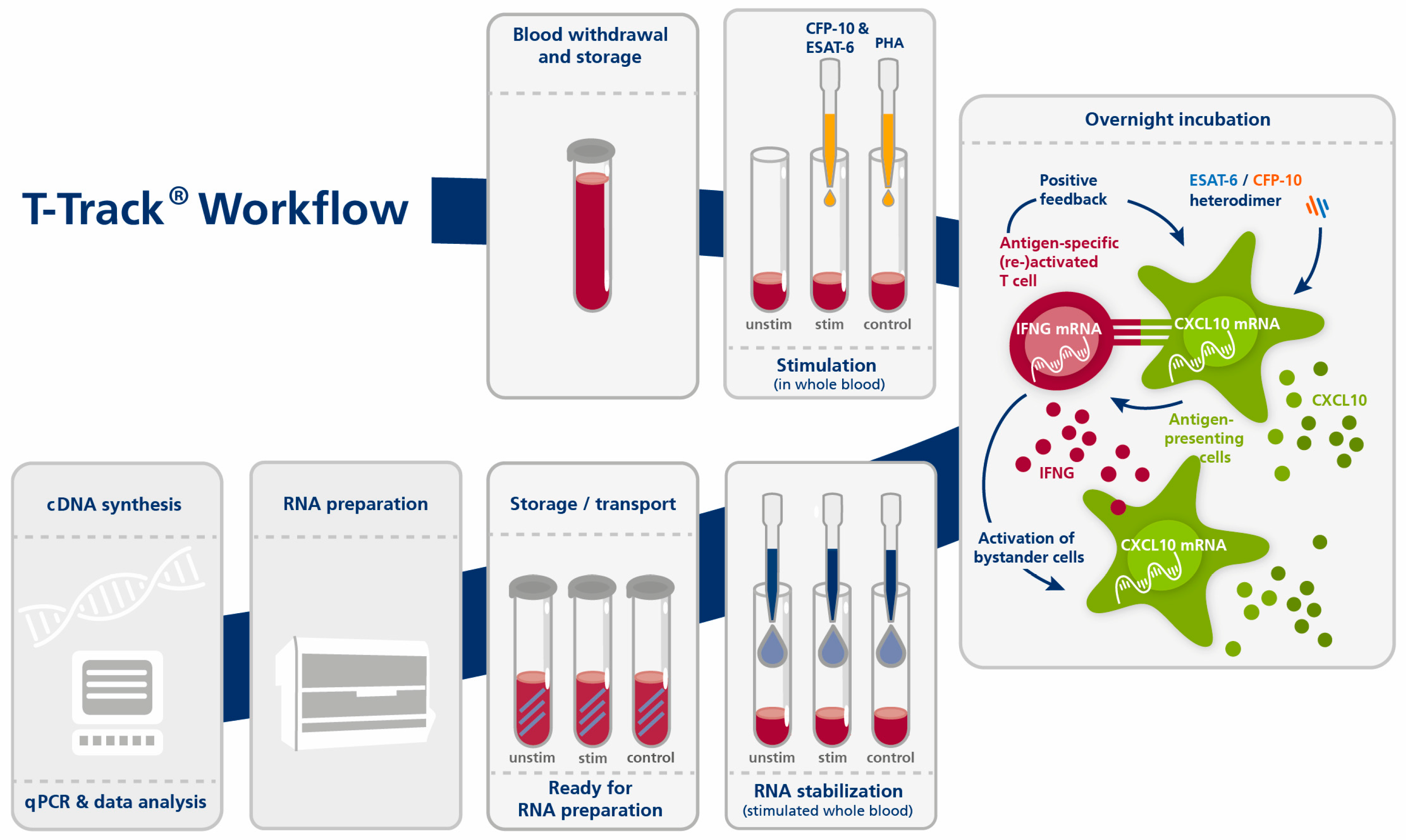
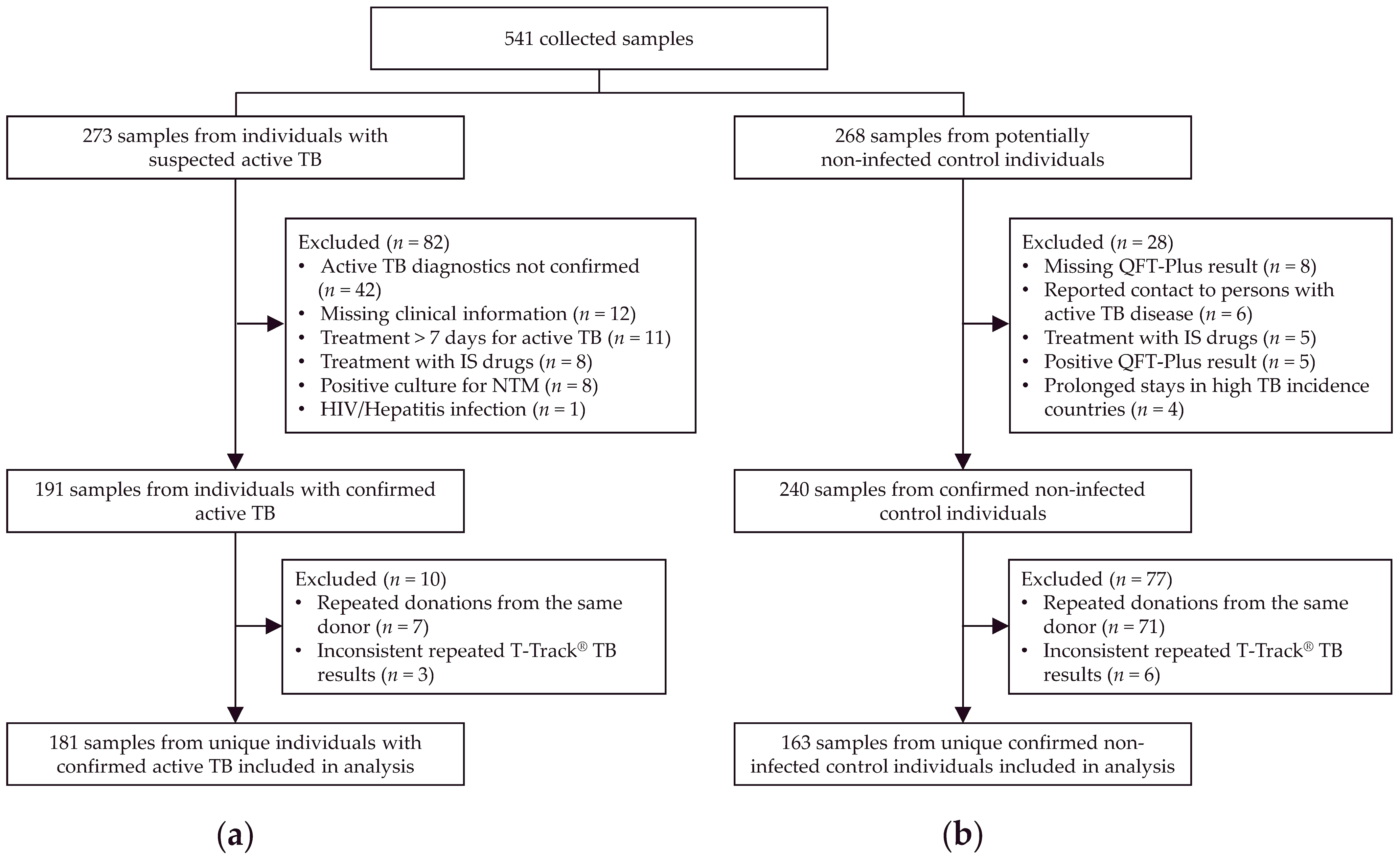
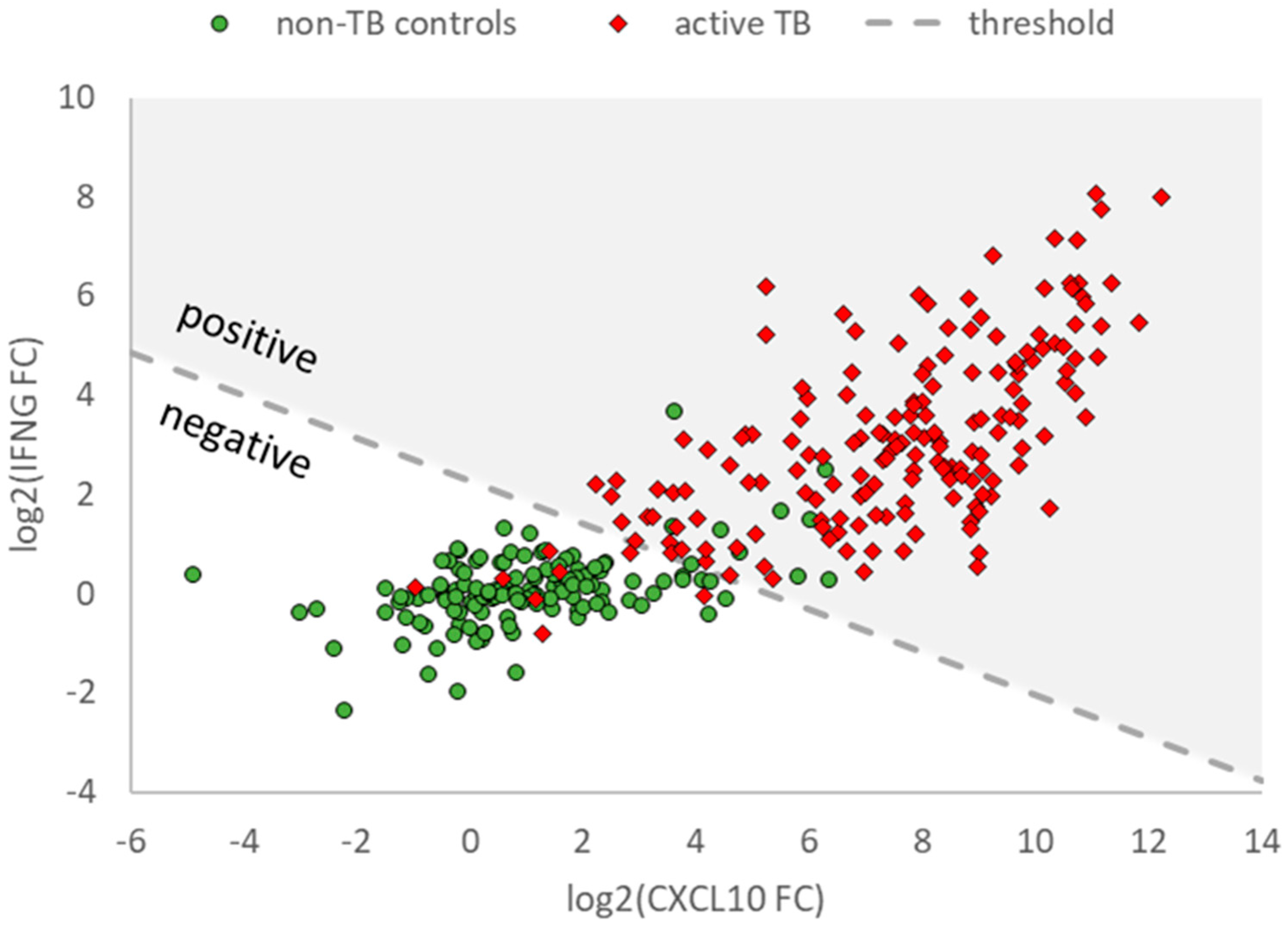
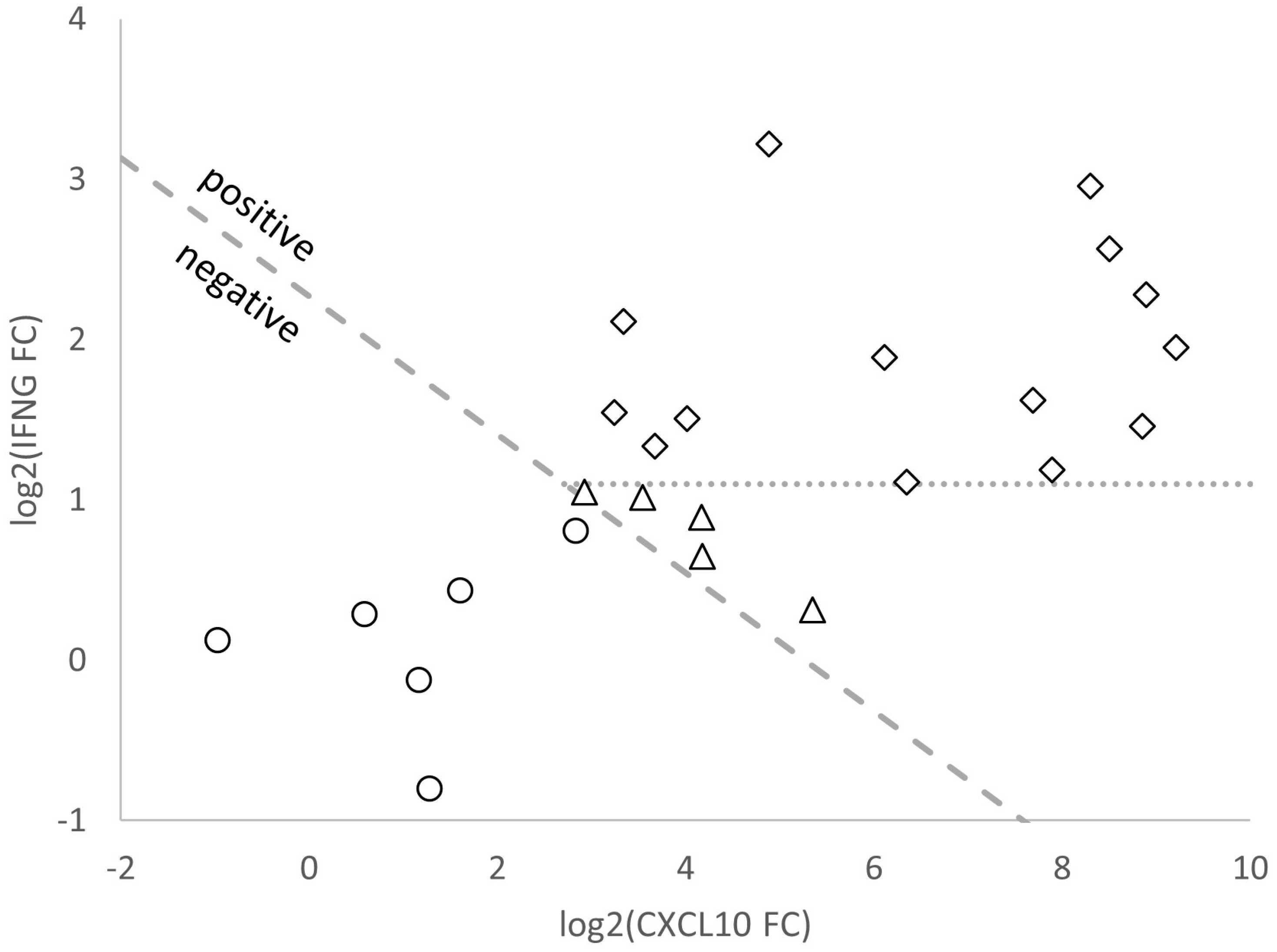
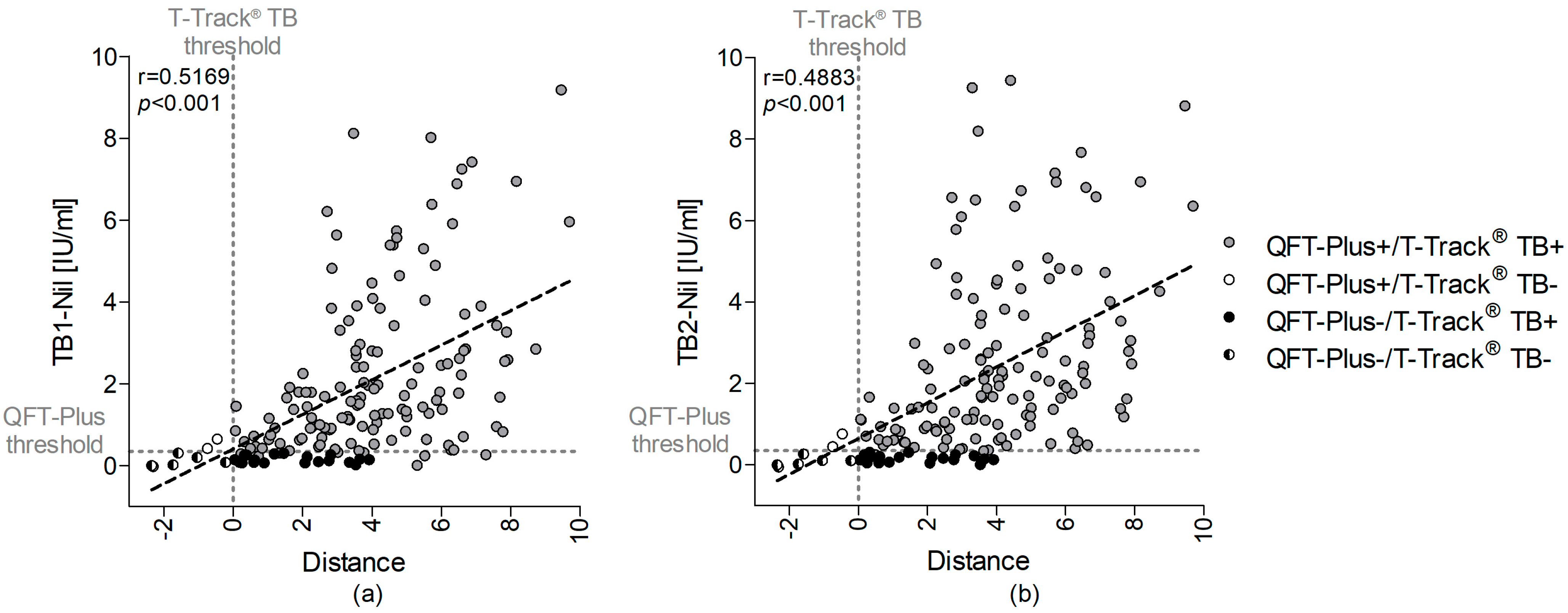
| Characteristics | TB Patients | Controls |
|---|---|---|
| Study population, N (%) | 181 (100.0%) | 163 (100.0%) |
| Age in years, median (range) | 35 (18–91) | 28 (18–78) |
| Sex, N (%) | ||
| Male | 125 (69.1%) | 59 (36.2%) |
| Female | 56 (30.9%) | 104 (63.8%) |
| Ethnicity, N (%) | ||
| African | 41 (22.7%) | 0 (0.0%) |
| Latin American | 2 (1.1%) | 0 (0.0%) |
| Asian | 40 (22.1%) | 1 (0.6%) |
| European | 95 (52.5%) | 162 (99.4%) |
| Unknown | 3 (1.7%) | 0 (0.0%) |
| Assay | Sensitivity n/N (%) [95% CI] | Specificity n/N (%) [95% CI] | Accuracy n/N (%) [95% CI] | Invalid Rate n/N (%) | Inconclusive Rate n/N (%) |
|---|---|---|---|---|---|
| T-Track® TB1 | 168/177 (94.9%) [90.5–97.4] | 151/161 (93.8%) [88.8–96.7] | 319/338 (94.4%) [91.3–96.4] | 4/344 (1.16%) | 2/344 (0.58%) |
| QFT-Plus2 | 150/178 (84.3%) [78.2–88.9] | n.d. 3 | n.d. 3 | 0/342 (0.00%) | 1/342 (0.29%) |
| T-Track® TB Result (n) | QFT-Plus Result (n) | Agreement % (95% CI) | Kappa Value (95% CI) | ||||
|---|---|---|---|---|---|---|---|
| Positive | Negative | Total | Overall Percent Agreement | Positive Percent Agreement | Negative Percent Agreement | ||
| Positive Negative Total | 146 2 148 | 19 7 26 | 165 9 174 | 87.9 (82.2–92.0) | 98.7 (94.9–99.9) | 26.9 (13.5–46.3) | 0.35 (0.15–0.56) |
Disclaimer/Publisher’s Note: The statements, opinions and data contained in all publications are solely those of the individual author(s) and contributor(s) and not of MDPI and/or the editor(s). MDPI and/or the editor(s) disclaim responsibility for any injury to people or property resulting from any ideas, methods, instructions or products referred to in the content. |
© 2023 by the authors. Licensee MDPI, Basel, Switzerland. This article is an open access article distributed under the terms and conditions of the Creative Commons Attribution (CC BY) license (https://creativecommons.org/licenses/by/4.0/).
Share and Cite
Meier, J.P.; Möbus, S.; Heigl, F.; Asbach-Nitzsche, A.; Niller, H.H.; Plentz, A.; Avsar, K.; Heiß-Neumann, M.; Schaaf, B.; Cassens, U.; et al. Performance of T-Track® TB, a Novel Dual Marker RT-qPCR-Based Whole-Blood Test for Improved Detection of Active Tuberculosis. Diagnostics 2023, 13, 758. https://doi.org/10.3390/diagnostics13040758
Meier JP, Möbus S, Heigl F, Asbach-Nitzsche A, Niller HH, Plentz A, Avsar K, Heiß-Neumann M, Schaaf B, Cassens U, et al. Performance of T-Track® TB, a Novel Dual Marker RT-qPCR-Based Whole-Blood Test for Improved Detection of Active Tuberculosis. Diagnostics. 2023; 13(4):758. https://doi.org/10.3390/diagnostics13040758
Chicago/Turabian StyleMeier, Johannes P., Selina Möbus, Florian Heigl, Alexandra Asbach-Nitzsche, Hans Helmut Niller, Annelie Plentz, Korkut Avsar, Marion Heiß-Neumann, Bernhard Schaaf, Uwe Cassens, and et al. 2023. "Performance of T-Track® TB, a Novel Dual Marker RT-qPCR-Based Whole-Blood Test for Improved Detection of Active Tuberculosis" Diagnostics 13, no. 4: 758. https://doi.org/10.3390/diagnostics13040758
APA StyleMeier, J. P., Möbus, S., Heigl, F., Asbach-Nitzsche, A., Niller, H. H., Plentz, A., Avsar, K., Heiß-Neumann, M., Schaaf, B., Cassens, U., Seese, B., Teschner, D., Handzhiev, S., Graf, U., Lübbert, C., Steinmaurer, M., Kontogianni, K., Berg, C., Maieron, A., ... Barabas, S. (2023). Performance of T-Track® TB, a Novel Dual Marker RT-qPCR-Based Whole-Blood Test for Improved Detection of Active Tuberculosis. Diagnostics, 13(4), 758. https://doi.org/10.3390/diagnostics13040758






